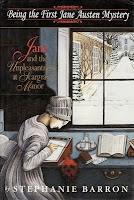Review: Being the First Jane Austen Mystery: Jane and the Unpleasantness at Scargrave Manor, by Stephanie Barron
 |
| Jane and the Unpleasantness at Scargrave Manor by Stephanie Barron (1996) |
As mentioned previously, Barron is well-known for her series which now consists of eleven novels, all pitting the beloved author, Jane Austen, as a veritable Jessica Fletcher. This first novel seems especially suited to a "Murder She Wrote" comparison, as Jane has gone to visit a friend (the wife of an Earl) and is present at the said Earl’s death. The mystery of who and why is as complex as any good murder mystery, though I must confess I harbor a preference for the arrogant Columbo style of already knowing who did it, almost before it’s done.
This novel is centered on a young bride from Barbadoes (inexplicably a friend of Miss Jane Austen) who is being pressured by debts to give up her childhood home of Crosswinds by the villainous Lord Harold, one of the last men to see her good husband alive. No one, it seems, can escape the possibility of guilt. Even Jane was present in the Earl’s last illness, and it is she who discovers the novel’s second body, as well as a melee of clues. When it seems the Countess and the new Earl are to be tried for the murders, Jane and the rest of the Scargrave party travel to London, where Miss Austen gains the assistance of her relations – a thing that makes this historical fiction buff proud.
Written in journal form (the novels are purported as seemingly “lost” manuscripts by Jane, sent to a niece of some sort for her amusement, and “never meant for publication”) the reader is saved from the boring third-person opinions of Miss Austen provided by other characters, and is instead installed in Austen’s head, as if along for the ride in one of her true letters, or in her novels. Austen is, of course, less omniscient in these entries than she is in her "known" works, where she is naturally all-knowing, but her wit and discernment are wonderfully characterized by Barron.
This novel is centered on a young bride from Barbadoes (inexplicably a friend of Miss Jane Austen) who is being pressured by debts to give up her childhood home of Crosswinds by the villainous Lord Harold, one of the last men to see her good husband alive. No one, it seems, can escape the possibility of guilt. Even Jane was present in the Earl’s last illness, and it is she who discovers the novel’s second body, as well as a melee of clues. When it seems the Countess and the new Earl are to be tried for the murders, Jane and the rest of the Scargrave party travel to London, where Miss Austen gains the assistance of her relations – a thing that makes this historical fiction buff proud.
Written in journal form (the novels are purported as seemingly “lost” manuscripts by Jane, sent to a niece of some sort for her amusement, and “never meant for publication”) the reader is saved from the boring third-person opinions of Miss Austen provided by other characters, and is instead installed in Austen’s head, as if along for the ride in one of her true letters, or in her novels. Austen is, of course, less omniscient in these entries than she is in her "known" works, where she is naturally all-knowing, but her wit and discernment are wonderfully characterized by Barron.
There are footnotes here and there which explain historical curiosities, but also serve to point out “inspirations” in Austen’s “real life” for later illustrated episodes of her novels. It may not be a perfect way to explain of the missing periods of Austen’s life (we’ll likely never have that) but this is certainly an amusing way to do so. With ten more books in the series to go, my only hope is that Barron can keep up the pace of the first one, as well as her talented hand for colorful supporting characters.

Comments
Post a Comment
Any and all feedback is welcome - thanks for taking the time!